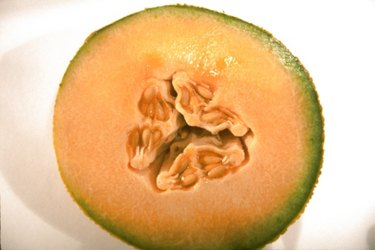
Cross-pollination refers to the act of one flower producing the pollen that fertilizes a second flower. True cross-pollination occurs between entirely separate plants; to be successful, cross-pollination requires two similar and compatible plants, which usually means they must be members of the same species. In some instances, members of different species and the same genus can cross-pollinate to produce hybrid plants, but these crosses rarely are successful. Watermelon and cantaloupe are members of the same family, but categorized in different genera and species. No successful crosses between members of different genera have been observed.
Fruit Development
Video of the Day
Cross-pollination is the sexual reproduction between two different flowering plants within the same species. Pollination results in fertilization of the flower's ovule. The ovule grows into seeds after fertilization, and the fruit engorges around the seeds. The purpose of the fruit is to protect, transport and feed the seeds. Without pollination and fertilization, no seeds develop. Without seeds, the plant does not produce any fruit. Because of the connection between pollination and fruit development, growers must pay attention to pollination during the blooming season to ensure a fruitful harvest.
Video of the Day
Purpose
Cross-pollination increases diversity because no two plant individuals are exactly the same. Each plant is a one-of-a-kind combination of the genetic contributions of the parents. Plants with favorable characteristics, such as color, size or scent, reproduce more often than plants with less favorable characteristics. This allows the entire plant population to slowly change overtime, adapting to changing environmental conditions. When a plant fertilizes itself, it is a clone of the parent plant and cannot adapt to a changing environment.
Cross-Pollination
Cantaloupe cross-pollinates between different varieties of cantaloupe, and watermelon crosses with other watermelons. They cannot cross-pollinate each other because the plants do not have similar enough genetic structures. When two plants cross-pollinate, the fruit of the current season is unaffected. The genetic makeup of the plant determines the characteristics of the fruit that plant produces. Cross-pollination creates seeds that combines one-half of the genetic information of one plant with one-half of the genetic information of a second plant, but it does not affect the genetic structure of the parent plant. The seeds grow into new plants with a different genetic structure than the parents, so the fruit produced on the daughter plants may differ from the parent's fruit.
Fruit Irregularities
When the fruit develops irregularly, or with unexpected characteristics, gardeners often suspect cross-pollination. Cross-pollination may be the culprit if the gardener plants seeds saved from a previous crop, and the unexpected fruit developed on daughter plants. If the fruit of a single plant is different from one season to the next, the most likely reason is environmental factors. Improper irrigation and fertilization practices, as well as disease and insect infestations can negatively impact the size, shape, color and flavor of the fruit, but cross-pollination will not change the fruit of a single plant in subsequent growing seasons.